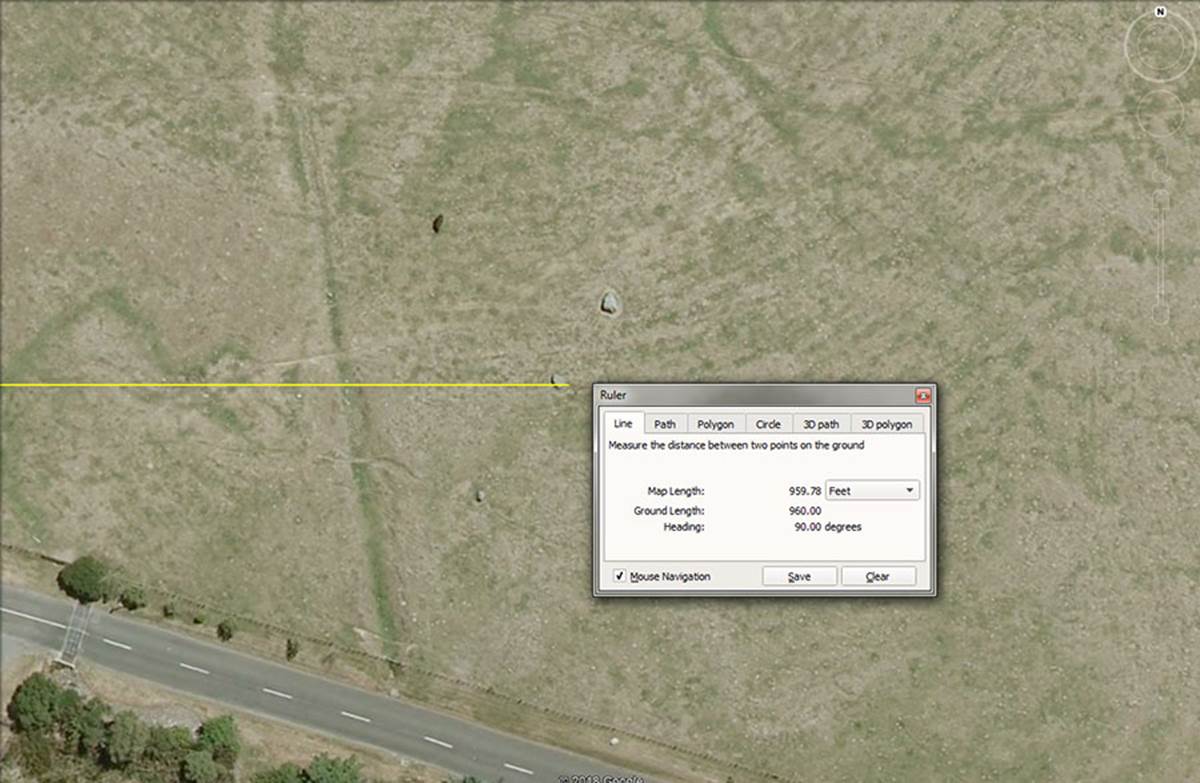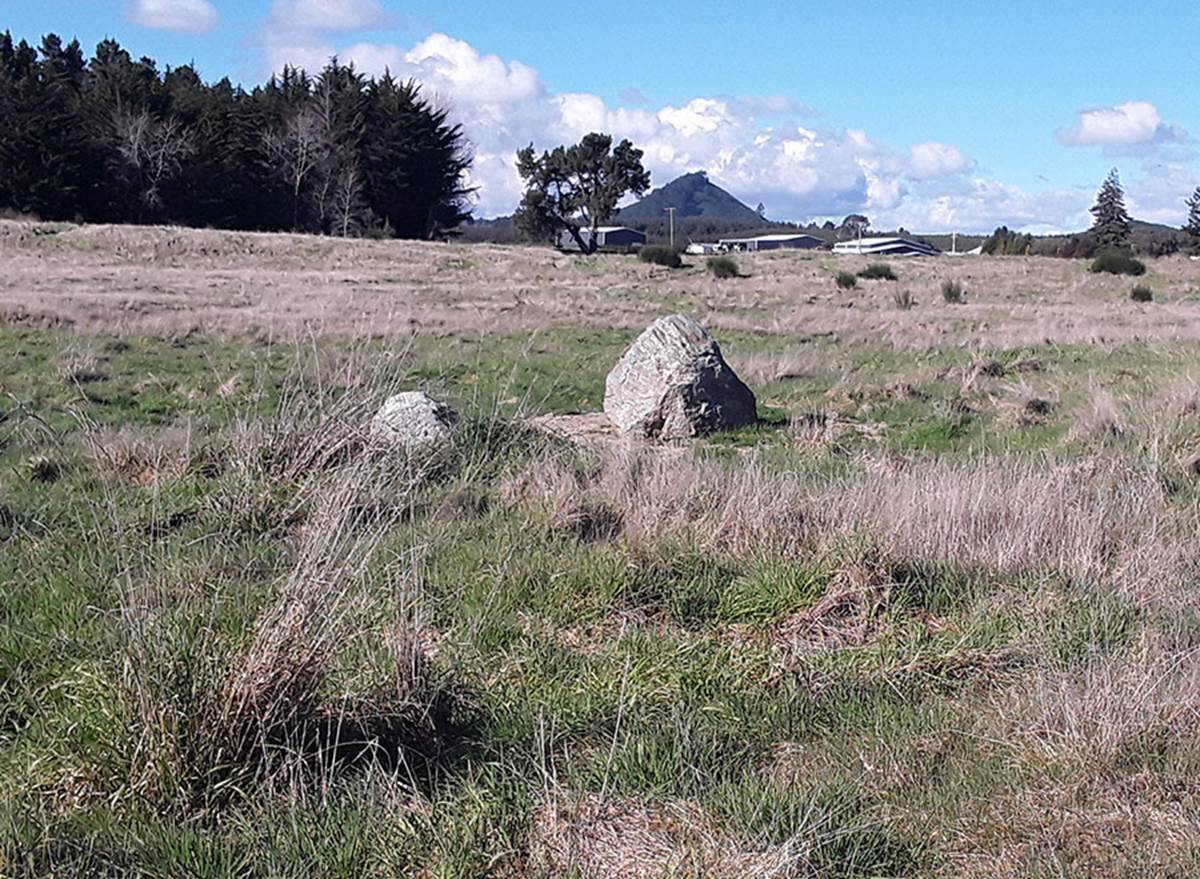
THE TRUE EAST MARKER FOR THE WHAREWAKA OBSERVATORY HUBSTONE.

From the hubstone at Wharewaka, the due east marker stone lies recumbent @ 960’ from the hubstone or 5 X the distance of the site’s close-in, due north marker, 120-feet from the hubstone.
In the above picture, the larger stone above the due-east line sits at a coded distance of 972’ from the hubstone @ 88-degrees. The 360-degree compass system is steeped in antiquity and is said to have been devised by the Sumerians (circa 3000 BC) but is obviously far older than that civilisation.

A magnified shot of the two boulders mentioned, with Mount Maunganamu in the background.
At the high inland terrain of the central volcanic plateau the larger boulder, @ 88-degrees azimuth, is on a perfect alignment to the southern base edge of Mt Maunganamu where first glint of the equinoctial sunrise would occur. The standing boulder therefore doubles as an equinox alignment outer-marker from the observer’s position at the hubstone. The now recumbent boulder in the above photo indicates due east or 90-degrees azimuth from the hubstone.
These first numbers mentioned, as distance and angle values out from the hubstone, are found repeatedly on Mediterranean and Continental European or British megalithic sites, so what scientific information or tutorials for students are encoded into these stone positions?
1. 120’ @ 90-degrees.
A mathematical progression based upon 12 or 120 goes:
120, 240, 360, 480, 600, 720, 840, 960, 1080, 1200, 1320, 1440, 1560, 1680, 1800, 1920, 2040, 2160, 2280, 2400, 2520, 2640, 2760, 2880, 3000, 3120, 3240, 3360, …. 5280, … 5760, … 7560, … etc.
The sum of 120-degrees would be 1/3rd of the 360-degree compass, 1320’ would be 1/4th of a mile of 5280’, 2160-years would be 1/12th of the 25920-year cycle of the Precession of the Equinoxes and the number of years the sun spends in each house of the zodiac during the cycle of precession, 25.2-inches would be 1 Assyrian cubit or 2 Greek feet, 756’ is the length of one side of the Great Pyramid of Egypt or 1/8th of 1-minute of equatorial arc for a world calculated to be 12 X 12 X 12 X 12 X 1.2 miles of 5250’ each (so-called ancient Greek miles) = 24883.2-miles.
2. A stone set at true north (0 or 360-degrees) would be very important for anyone wanting to accurately determine angles to any target on the horizon. Ancient surveyors of circa 3000 BC and thereafter used alidade sighting rules that could spin through a 360 degree calibrated circle drawn on a wooden plane table. Such a device set up atop the designated hubstone from which all reading were taken, would first be zeroed onto the true north obelisk position 120’ away. A second check would be to sight down the alidade sighting rule to the 90-degree positioned obelisk 960’ away at due east. Once accuracy was achieved one could swivel the sighting rule, say, to point at the cone summit of Mount Ruapehu volcano and know that it sat away at 215.6-degrees azimuth.
3. The larger boulder sitting upright over to the east @ 88-degrees and 972’ distant provided the following distance and angle encoded information:
A mathematical progression based upon 97.2 goes:
97.2, 194.4, 291.6, 388.8, 486, 583.2, 680.4, 777.6, 874.8, 972, 1069.2, 1166.4, 1263.6, 1360.8, 1458, 1555.2, 1652.4, 1749.6, 1846.8, 1944, … 2430, … 3110.4, …. 3402, … 12441.6, … 24883.2.
This string relates to what Julius Caesar said about the druidic preoccupation of lecturing concerning "the magnitude of the Earth and its divisions", in values of 1/2, 1/4, 1/8th, 1/16th, 1/32nd, 1/64th, 1/128th, 1/256th, etc. In this line-up the sum of 97.2-miles would be 256th of the 24883.2-mile circumference, whereas 1555.2-miles would be 1/16th part and 12441.6-miles half.
Important numbers that occur in this string that were used in other calculation functions are: 58.32 (1 Roman Pace was made up of 5 Roman feet of 11.664-inches each), 6804 (the number used in ancient times to describe the duration of the lunar nutation cycle in days), 1360.8 (with the Earth anciently described as having a circumference of 24883.2-miles, that means it is rotating at a rate of 1036.8 MPH in a 24-hour period).
As for the 88-degrees angle that this boulder sits at away from the hubstone, we have the following progression:
88, 176, 264, 352, 440, 528, 616, 704, 792, 880, 968, 1056, 1144, 1232, 1320, … 1584, … 1760, … 2112, … 5280, … 11000, etc.
This is an “11” number family progression, with all values listed divisible by “11”. It was out of the “11” family that the so-called British Standard mile (5280-feet) and league (16500-feet) were created for navigation overland or across the vast, featureless oceans. The “11” system was particularly accurate for positional plotting and dead-reckoning at sea, as straight line sea-leg tacks, in leagues, convert to sexagesimal circles on the navigator’s plotting table, which are fluidly divisible by 360-degrees. This meant that the angle back to the port of departure or onwards to the destination port could be calculated with excellent relative accuracy, despite many course changes over a ley-line when zig-zagging a sailing-ship on the wind.
IS THERE ANYTHING IN HISTORICAL TEXTS TO CORROBORATE THIS KIND OF ACTIVITY?
Julius Caesar, who was a very thorough historian, writes the following regarding the late era druids of his time (circa 55 BC) and practices within their many universities in Britain, where students from Gaul and elsewhere, including Rome, went for training:
'They hold aloof from war and do not pay war taxes; they are excused from military service and exempt from all liabilities. Tempted by these great advantages, many young men assemble of their own motion to receive their training, many are sent by parents and relatives. Report says that in the schools of the Druids they learn by heart a great number of verses, and therefore some persons remain twenty years under training'.
'They do not think it proper to commit these utterances to writing*, although in all other matters and in their public and private accounts they make use of Greek characters. I believe that they have adopted the practice for two reasons- that they do not wish the rule to become common property, nor those who learn the rule to rely on writing and so neglect the cultivation of memory; and, in fact, it does usually happen that the assistance of writing tends to relax the diligence of the student and the action of memory...They also lecture on the stars in their motion, the magnitude of the Earth and its divisions, on natural history, on the power and government of God; and instruct the youth in these subjects' (see De Ballo Gallico, VII, 15, 16.).
*Note: They encoded their navigational & cyclic astronomy sciences in numbers, by building standing stone circles and arrays out from a hubstone. The special numbers were extractable by length measurements and angle readings within a 360-degree compass disc. The huge, durable stones thus became silent sentinels and repositories of codes for as long as they remained in position, spanning thousands of years.
Historian, Isabel Hill Elder writes, 'The students at these colleges numbered at times sixty thousand of the youth and young nobility of Britain and Gaul. Caesar comments on the fact that the Gauls sent their youth to Britain to be educated...It required twenty years to master the complete circle of Druidic knowledge. Natural philosophy, astronomy, mathematics, geometry, medicine, jurisprudence, poetry and oratory were all proposed and taught-natural philosophy and astronomy with severe exactitude' (Elder refers to Strabo I IV, page 197. Caesars Comm. Lib V. Sueotonius, V Calegula. E. Campion, Accounts of Ireland, pg. 18.).
Isabel Hill Elder further writes, 'The education system adopted by the Druids is traced to about 1800 BC when Hu Gardarn Hysicion (Isaacson), or Hu the Mighty, led the first colony of Cymri into Britain from Defrobane, where Constantinople now stands'.
Further commenting on Hu Gardarn Hysicion, Isabel Hill Elder writes that he, 'is commemorated in Welsh archaeology as having made poetry the vehicle of memory'. Elsewhere she writes, he 'is said to have mnemonically systematized the wisdom of the ancients...'.
She goes on to say, 'The published compositions of the Druids and Bards form but a very small portion of the extant remains of their works. The Myvyrian MSS. alone, now in the British Museum, amount to 47 volumes of poetry, in 1600 pages, besides about 2000 epigrammatic stanzas. Also in the same collection are 53 volumes of prose, in about 15,300 pages, containing many curious documents on various subjects...' (see Celt, Druid and Culdee, pages 54 & 55).
With the testimony of Julius Caesar ringing in our ears, let’s see how the druids would have mathematically encoding astronomical cycles, ("the stars in their motion"), navigation systems ("the magnitude of the Earth and its divisions"), ... "astronomy, mathematics, geometry" ... "and astronomy with severe exactitude".
THE TONGARIRO MOUNTAIN BENCHMARK

A surveying line of 220-degrees runs for 35.5-miles from the hubstone to the highest surviving region of Mount Tongariro, a dormant volcano that periodically erupts. The line skims past the SE edge of Motutaiko Island, providing a secondary station for correct orientation to the benchmark target.

From the hubstone position, a surveying line resolves upon the highest terrain of Mount Tongariro (which translates to, ”going to the south”).
The whole number angle of 220-degrees to Tongariro could be used for accurately calibrating a 360-degree disk for fixes onto all other visible targets around the horizon. The three majestic mountains could be seen from many far-flung locations and represented the most used directional markers for orientation within the North Island of New Zealand.